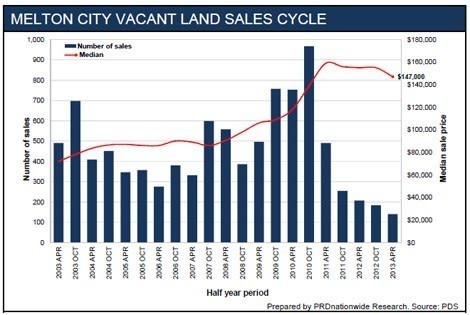Melton forecast to grow strongly over next 25 years: PRDnationwide
Over the next 25 years the Melton growth area is forecast to grow strongly, with around 37,000 homes built for 117,000 people providing an estimated $6 billion of business investment.
With land around Caroline Springs already established, most residential growth is expected to be in Melton City taking advantage of its modern shopping and commercial centre, diverse housing mix, and entertainment and education opportunities.
The growth is expected to provide 25,000 jobs, transforming Melton City -- about 35 kilometres west of Melbourne -- into a vibrant business and residential satellite area.
The Melton growth area takes in Melton City, Caroline Springs, Taylors Hill, Hillside and Ravenhall. The eastern part of the growth area -- Caroline Springs and Taylors Hill -- have experienced rapid growth over the past five years with large scale development of detached, private homes.
The introduction of an increasing number of second and third home buyers into the area, as the population matures, is becoming evident.
A report by researchers PRDnationwide looks at historic and current market trends in the Melton area’s house, unit and vacant land markets which are well serviced by the Western Freeway.

Caroline Springs and Melton City both had comparable trends in terms of transaction numbers and median house price. The Melton City Area had more house sales over the past decade -- an average of 444 per half year -- with Caroline Springs Area averaging 378.
Median house prices tracked concurrently, with Melton City and Caroline Springs having 5.8% and 5.5% per annum increases since April 2003. The Caroline Springs median closed in April this year at $430,000 - much greater than the Melton City median of $280,000. This suggests proximity to the Melbourne CBD plays a large part in shaping the market of 25 square kilometres.
Over the year to April 2013, Melton City had a 6% increase in house transactions while Caroline Springs had negligible change with three more sales. Kurunjang (14%) and Melton (4%) had the most sales in the Melton City area, while Caroline Springs and Burnside -- closer to the Melbourne CBD -- had 7% and 5% increases.
The Melton City Area house market (2: see chart highlighted yellow) had continual median price increases of 5.8% per annum over the decade to May, with a median price of $280,000. Despite a recent fall in the number of sales, the half year had 366 sales compared with the 10-year average of 444 -- a 1.1% per annum decline.
The best performing suburbs over the past year were Melton and Kurunjang, both north of the Melton Freeway, with 4% and 14% increases in transactions. Suburbs to the southwest -- Melton West (-8%), Melton South (-13%) and Brookfield (-21%) -- registered drops in sales.
As the Melton LGA grows, continuing demand for medium density unit type dwellings will expand with population growth. The median sale price for units in the region closed in the six-month period to May at $230,000 -- a 12-month median price jump of 2.2%.

The strong 10-year growth rate of 5.5% per annum shows that, while unit sales are not large, the market for multifamily accommodation remains a sound investment, the report found.
Vacant land in Melton is always sought after for development. The market for vacant land closed the six months to April at $147,000 -- or 5.2% down on the April 2012 figure -- yet up over the past decade by 7.4% per annum.
A decline in vacant land sales suggests dwindling stock levels paired with inadequate residential land development.

‘’As we see the correction of the median vacant land price we may expect to see another positive shift as the need for urban growth in Melbourne’s west continues,’’ the report says.
The Caroline Springs Area includes Hillside, Taylors Hill, Burnside, Burnside Heights Ravenhall and Caroline Springs. Despite being inside the Melton LGA, the market actually reflects the Brimbank LGA immediately east which predominantly shapes Melbourne’s outer western – as opposed to northern -- suburbs, the report says.
The Caroline Springs Area house market has seen continual median price increases of 5.5% per annum over the past decade to April with a median of $430,000. Despite a recent negative shift in the number of transactions for the area spurred by the Global Financial Crisis, the half-year period ending April had 289 transactions compared with the 10-year average of 373 sales. This is a small yearly increase in transactions of 3.8%.
Best performing median price suburbs over the past year are Taylors Hill on $483,000, followed by Caroline Springs ($420,000) and Burnside Heights ($411,500). Burnside had the most affordable housing in the Caroline Springs Area with a median of $390,000 from 35 transactions in the year to April.

The Caroline Springs Area vacant land market has experienced high residential development over the past decade. Large areas of vacant land have been sold resulting in a spike in median prices as land is developed.
The Caroline Springs Area has had a 9.2% per annum increase in the vacant land median in the decade to May. It has more than doubled over the past decade to $292,000.
From June 2001 to May 2002 there were 2256 vacant land sales -- about 93% more than the 160 over the same period 12 years on.
This shows the Caroline Springs Area is exhausting its vacant land with the median sale price plateauing and the number of transactions in continual decline.
Photo courtesy of commons/flickr.
